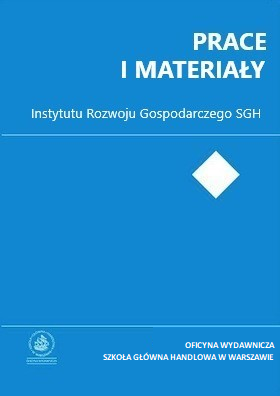The procedure of business cycle turning points identification based on hidden Markov models
##plugins.themes.bootstrap3.article.main##
Abstrakt
In the paper the procedure, based on hidden Markov chains with conditional normal distributions and uses algorithms such as time series decompositions (STL), Baum-Welch algorithm, Viterbi algorithm and Monte Carlo simulations, is proposed to analyze data out of the business tendency survey conducted by the Research Institute for Economic Development, Warsaw School of Economics. There are considered three types of models, namely, with two-state, three-state and four-state Markov chains. Results of the procedure could be treated as an approximation of business cycle turning points. The performed analysis speaks in favor of multistate models. Due to, an increasing with the number of states, numerical instability, it is not obvious which model should be considered as the best one. For this purpose various optimization criteria are taken into consideration: information criteria (AIC, BIC) and the maximum-likelihood, but also frequency of obtaining a given set of parameters in the Monte Carlo simulations. The results are confronted with the turning points dated by OECD. The tested models were compared in terms of their effectiveness in detecting of turning points. The procedure is a step into automation of business cycle analysis based on results of business tendency surveys. Though this automation covers only some models from millions of possibilities, the procedure turns out to be extremely accurate in business cycle turning points identification,(original abstract)
##plugins.themes.bootstrap3.article.details##
Bibliografia
Abberger, K., Nierhaus, W. (2010). Markov-switching and the Ifo business climate: the Ifo business cycle traffic lights, Journal of Business Cycle Measurement and Analysis, 2, 1-13.
Addo, P. M., Billio, M., Guegan, D. (2012). Alternative methodology for turning point detection in business cycle: A wavelet approach, Documents de travail du Centre d’Economie de la Sorbonne, 23.
Baum, L. E., Petrie, T., Soules, G., Weiss, N. (1970). A maximization technique occurring in the statistical analysis of probabilistic functions of Markov chains, The Annals of Mathematical Statistics, 41 (1), 164-171.
Bell, W. (1984). Signal extraction for nonstationary time series, Annals of Statistics, 12 (2), 646-664.
Bernardelli, M. (2012). Non-classical Markov models - numerical problems, manuscript.
Bernardelli, M. (2013a). Non-classical Markov models in the analysis of business cycles in Poland, Roczniki Kolegium Analiz Ekonomicznych SGH, 30, 59-74.
Bernardelli, M. (2013b). Optimization criteria in the algorithm using hidden Markov models in the analysis of the economic data, in Rola informatyki w naukach ekonomicznych i społecznych. Innowacje i implikacje interdyscyplinarne, vol. 2, Zieliński Z. (ed.), Kielce: Wydawnictwo Wyższej Szkoły Handlowej, 43-53.
Bernardelli, M. (2014). Parallel deterministic procedure based on hidden Markov models for the analysis of economic cycles in Poland, Roczniki Kolegium Analiz Ekonomicznych SGH, 34, 75-87.
Bernardelli, M., Dędys, M. (2012). Hidden Markov models in analysis of results of business tendency surveys, Prace i Materiały Instytutu Rozwoju Gospodarczego SGH, 90, 159-181.
Bhar, R., Hamori, S. (2004). Hidden Markov Models. Applications to Financial Economics, New York: Springer.
Birchenhal, C. R., Jessen, H., Osborn, D. R., Simpson, P. (1999). Predicting US business-cycle regimes, Journal of Business and Economic Statistics, 17 (3), 313-323.
Cappé, O, Moulines, E., Rydén, T. (2005). Inference in hidden Markov models, New York: Springer.
Chin, D., Geweke, J., Miller, P. (2000). Predicting turning points, Technical Report 267, Reserve Bank of Minneapolis.
Christiano, L. J., Fitzgerald, T. J. (2003). The band pass filter, International Economic Review, 44 (2), 435-465.
Cleveland, R., Cleveland, W. S., McRae, J. E., Terpenning, I. (1990). STL: A seasonal-trend decomposition procedure based on ‘loess’, Journal of Official Statistics, 6, 3-73.
Cleveland, W. S. (1972). Analysis and forecasting of seasonal time series, PhD thesis, University of Wisconsin-Madison.
Dorosiewicz, S. (2013). Koniunktura w transporcie. Metodyka badań, wyniki, modele, Warszawa: Instytut Transportu Samochodowego.
Durbin, R., Eddy, S., Krogh, A., Mitchison, G. (1998). Biological sequence analysis: Probabilistic models of proteins and nucleic acids, Cambridge: Cambridge University Press.
Ghahramani, Z. (2001). An introduction to hidden Markov models and Bayesian networks, International Journal of Pattern Recognition and Artificial Intelligence, 15 (1), 9-42.
Hamilton, J. D. (1994). Time series analysis, Princeton.
Hodrick, R. J., Prescott, E. C. (1997), Postwar US business cycles: An empirical investigation, Journal of Money Credit and Banking, 29 (1), 1-16.
Jelinek, F. (1997). Statistical methods for speech recognition, Cambridge: MIT Press.
Koskinen, L., Oeller, L. E. (2004). A classifying procedure for signaling turning points, Journal of Forecasting, 23 (3), 197-214.
Lamy, R. (1997). Forecasting US recessions: Some further results from probit models, Technical report, Finance Canada.
Mamon, R. S., Elliott, R. J. (eds.) (2007). Hidden Markov models in finance, New York: Springer.
Mitra, S., Date, P. (2010). Regime switching volatility calibration by the Baum-Welch method, Journal of Computational and Applied Mathematics, 234, 3243-3260.
Rabin, M. O. (1963). Probabilistic automata, Information and Control, 6 (3), 230-245.
Sensier, M., Artis, M., Osborn, D. R., Birchenhall, C. R. (2004). Domestic and international influences on business cycle regimes in Europe, International Journal of Forecasting, 20 (2), 343-357.
Viterbi, A. (1967). Error bounds for convolutional codes and an asymptotically optimum decoding algorithm, IEEE Transactions on Information Theory, 13 (2), 260-269.
Wildi, M., Schips, B. (2005). Signal extraction: How (in)efficient are model-based approaches? An empirical study based on TRAMO-SEATS and Census X12-ARIMA, Technical Report 96, Zurich: KOF Swiss Economic Institute.
